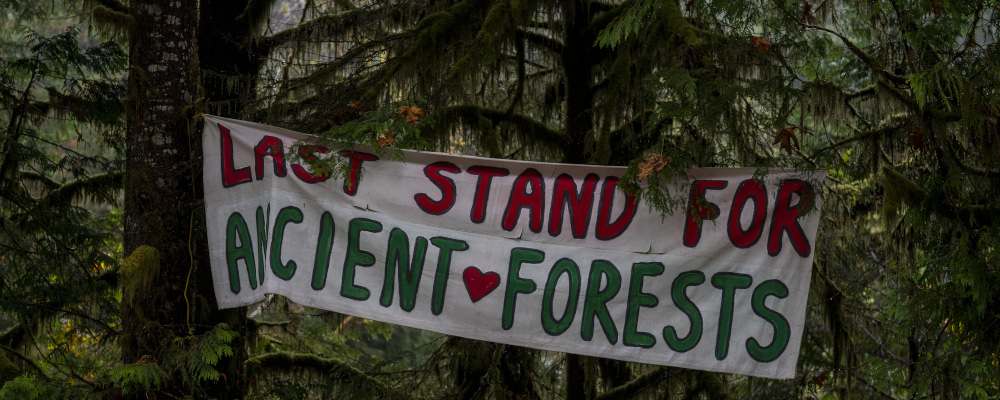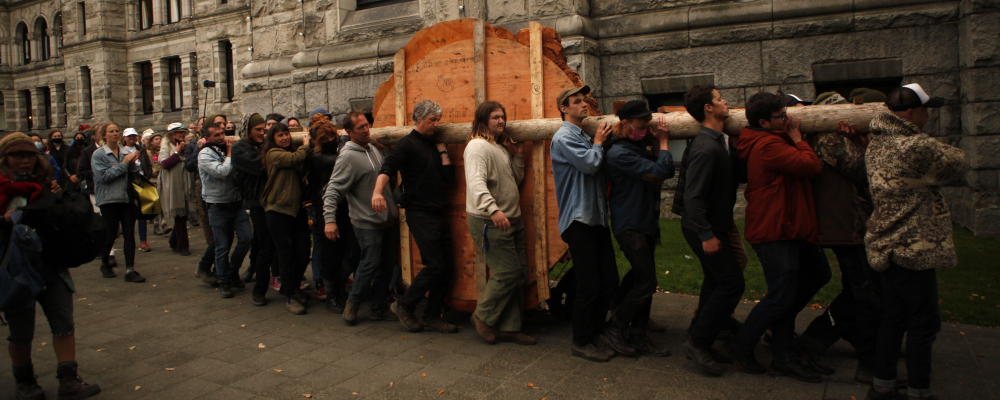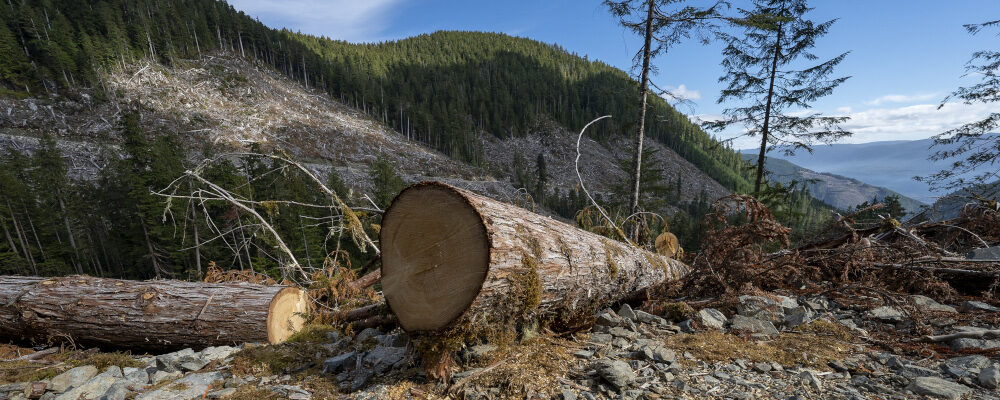It’s been two summers since I visited the anti-logging protest camps at Fairy Creek on the southwest side of Vancouver Island, and I still can’t fully reconcile the conflicting views I have about them. On the one hand, I do think the RCMP overreached in its treatment of the protesters, but I also think the RCMP should have done a better—a more lawful and efficient—job enforcing the logging company’s injunctions against the protesters. And on the merits of the case I side with the protesters, even as I find them personally unsympathetic. In the face of rational uncertainty, I am forced to fall back on instinct and there the matter is clear: I oppose logging old growth forests.
I went to Fairy Creek intending to write about what I saw, but I was there for such a short time that when I sat down at my computer I concluded that my observations and insights didn’t justify my contribution. They probably still don’t, but I was reminded of my visit this week when I received an email asking me to send a message to federal government ministers in support of Motion M-83 by MP Patrick Weiler (West Vancouver–Sunshine Coast–Sea to Sky Country). The motion calls on the government to protect old-growth forests by:
- ending the destruction of old growth forests on federal land;
- prioritizing and funding the long-term protection of endangered old growth forest ecosystems;
- launching the Old Growth Nature Fund before the end of 2023 to finance the protection and conservation of the remaining old growth forest in Canada; and
- banning the export of old growth logs and wood products made from old growth trees, from and through Canada by 2030.
The email caused me to go back to my notes from June 2021 and to consider how my thoughts then and now bear on Mr Weiler’s motion. My conclusion is that M-83 is, on balance, a good motion. I don’t agree with everything in it, especially in the preamble, but subjective perfection is an impossible standard in deliberative politics. I added my name to the petition. What follows is my attempt to explain why.
Before I visited Fairy Creek, I read the cases for and against the protests, including the controversy over how to usefully define “old growth.” I read the letters from local elected First Nations leaders accusing the protesters of colonial presumption, and I heard the frustration of local foresters at interlopers shutting down the work that has sustained their community for more than a hundred years. I also read the report on “forests and forest-dependent communities” by the UBC Faculty of Forestry and the B.C. NDP government’s Old Growth Strategic Review report, each of which argued for different balances between industrial logging and conservation. But I wanted to see for myself.
When I decided to visit in June 2021, self-described “land defenders” had been encamped for a little less than a year fighting to stop the logging of old growth forest near a pristine watershed. With the sort of name propagandists dream of, Fairy Creek had attracted protesters from across Canada. There had already been 260 arrests, but by the end of August, the number of arrests would grow to 800, and by the end of 2021 almost 1,200 arrests would make it the largest act of civil disobedience in modern Canadian history. That was still in the future, but everyone I met at the time could have told you it would happen.
As I approached the site, I passed about half a dozen police cars parked along the side of the road. The week before my visit, the police had raided several of the camps further up the mountain, where protesters were digging in to stop the logging company building new roads. They had chained themselves to camp buildings, locked and cemented themselves into trenches on the road impeding logging equipment, and balanced themselves precariously up trees leaning above road or, in one case, over a gorge next to the road. But the officers I saw were relaxed. Reclining in their seats with their sunglasses on, they looked like they were napping. There would be no confrontations today.
Before I reached the base camp, “Fairy Creek HQ,” I had to pass through two road blocks about a hundred yards apart on a dirt access road, each manned by young protesters. Given the lingering tension from the recent arrests, I expected them to be more suspicious, but after a couple of questions they were satisfied that I just wanted to look around and they directed me to a gravel parking area a few hundred yards further up the road. The only things they asked were whether I was planning to stay the night (I was not), whether I had brought supplies (I had not), and not to take photographs of individual protesters or camp infrastructure.
Almost as soon as I arrived, I was conscripted by a man called “Moth” into carrying a large pot of soup around the lower part of the base camp. Moth was tall, about 30 years old, lean and tanned like rock-climber and looked like he’d been living outdoors for several weeks. While protesters ladled lunch into their personal bowls, I asked him about his time at the camp. He was happy to talk and blithely incurious about me. The campers were evidently used to transients. From what I could tell, the permanent population of the camp was relatively small—maybe a few dozen—and supplemented by short-term residents who would pitch up for a week or two, as well as people who would drive from as far away as Kamloops to deliver supplies.
I didn’t stay long, just long enough to hike up past Red Dress Camp to River Camp, two of the camps that would later be dismantled by the police and then reclaimed and rebuilt. River Camp was about two hours up the mountain, much closer to the main watershed. It felt simultaneously temporary and well-worn, with huts made of plywood, timber, and tarp, and individual tents scattered behind and around them. It was mostly deserted—I was told by a woman in a heavy formless sweater with matted grey hair that the others were out on reconnaissance, whatever that meant. Beyond the small camp, you didn’t have to walk far into the forest to be absorbed into the intense stillness. Pushing through damp ferns under the high canopy, fifty feet from the trail felt like fifty miles.
Writers trying convey what it’s like to stand in old growth forests often reach for a comparison to cathedrals. There is even a famous stand of old trees on Vancouver Island called Cathedral Grove. As you walk among them, the thick trunks recede in all directions and taper out of sight above, and a quiet heaviness hangs over the tall spaces in between. Your own sound is as intrusive as the echo of heels on the flagstones of an empty church. But it is important to remember that the analogy properly goes the other way. More than just structural necessity, the fluted columns of the great cathedrals, like the earlier columns of Roman basilicas and the hypostyle halls of Egyptian temples dense with dendriform pillars, brought the hushed reverence of the forest indoors as a setting fit for worship.

Most of the people I spoke to were friendly enough, especially the youngest and the oldest. Passionate and optimistic, they were happy to talk about what they thought the government should be doing to defend old growth and were especially contemptuous of NDP leader John Horgan, who was also the local MLA. Many of the protesters were students or recent graduates, and though they were serious about the cause they smiled easily and I could see them eventually settling into NGO or government jobs. The retired professionals in Patagonia fleece vests and Tilley hats, with whom the younger set chatted cheerfully, offered a greying image of their futures.
One of the older men, a part-time journalist chronicling his time at the camp for alternative online publications, told me that he had been among those arrested the week before. He had spent six hours in the back of a hot paddy wagon before being driven to a police station and released without booking. He said this “catch and release” was a common tactic and, because they weren’t actually arrested, they weren’t able to challenge the legality of the arrest directly. I mumbled tepid commiseration. My sympathy for police confronting obdurate illegality is strong, but I reminded myself that the rule of law is not just neutral as between law-enforcer and law-breaker, it defines which is which.
As I got farther into the base camp, I also became aware of another type of protester, more reserved, more serious. Mostly but not exclusively men, these people appeared to be in charge. They weren’t exactly unwelcoming, but in contrast to the people I first encountered they made no effort to hide their wariness. No doubt it was well-earned. The few I spoke to were veterans of environmental protests. They were not idealists. Talking to one of them, I was struck by the rawness that is left when hope runs out. He had fought and lost too often. He was angry and his open contempt for humanity was beyond antisocial, it was sociopathic. He was the exception among those I spoke to, but although I couldn’t imagine him fitting in anywhere else, he had a place there.
I asked another of these veterans how they were handling their dispute with local First Nations leaders. He was blunt. He said he didn’t care who owned the land, he was there for the trees. He told me that if the First Nations didn’t care for the land, then they had no right to stop the people who did. He said he saw no difference in principle between the provincial government and First Nations’ governments: one was corrupt and the other had been corrupted. The only people he would listen to were those committed to ending old growth logging. It was an unusually stark view of what was at stake, but it differed from what I heard from others only in its antinomian honesty.
I can’t say I liked the people I met at Fairy Creek, but that doesn’t matter: you don’t have to like someone to agree with them. We would do better as a society if we remembered that. It’s an understandable reflex to dislike whatever someone you dislike is doing or, equally unhelpfully, to agree with whatever someone you like supports. But it confounds good public policy when we evaluate ideas based on who proposes them. I felt this poisonous impulse in myself at Fairy Creek. The more I talked to the people in the camps, the less I liked their cause, while the further I got from the protesters and into the forest, the more I understood why they were there.

Two years later, it’s not clear who “won” and who “lost” at Fairy Creek. In the spring of 2022, the provincial NDP government announced a deferral of 1.7 million hectares of old-growth forest, which it later increased to 2.1 million hectares, but neither the forestry industry nor the former camp protesters are happy with the decision and local First Nations remain torn between the sides and divided among themselves. As for me, my instinct for conservation is unchanged. I am happy to be told that this is a naïve and ignorant opinion, and I’ve spoken to people more knowledgeable than me who have explained why it is. But while I may vacillate on other aspects of the protests, I can’t shake that core conviction.
The timber industry is important to the economy and the culture of British Columbia; much of the province was quite literally built by local timber. But the industrial depletion of old growth has left only a small fraction of the oldest parts of the ancient forests intact. It is too late to save what is lost, but what remains we must preserve and steward wisely. The intangible worth of the oldest trees is incommensurable with any commercial value. “Old growth” on Vancouver Island means more than 250 years old, but some of the trees that have been cut are much, much older, some more than a thousand years old.
Because a society is an intergenerational compact, we must conserve for the common good things that cannot be replaced within our lifetimes or, in the case of the oldest trees, within fifty generations. No profit can compensate for the loss of a tree that was already 200 years old when Magna Carta was signed and more than 400 years old when Gutenberg printed his first Bible, and certainly not the trivial commercial value of the wood.
The value of all the timber in Teal-Jones’s licensed harvesting area, of which Fairy Creek is just a small part, is $20 million, less than what the B.C. government spends to build a single new school. With so much at stake for so little, I can’t believe it isn’t possible to make everyone, if not happy, then at least whole.




